The clatter of roller bags being dragged across the cobblestoned courtyard behind the hotel at 5:00 a.m. immediately dispelled any illusions we might have had upon waking that we were still on a cruise ship, silently gliding into port. A quick look around confirmed that we were no longer in our cabin on the Star Breeze, where there was a space for everything and everything was in its space, but now in a cramped room where there is space for nearly nothing. By rearranging the room last night for optimal air circulation, we had made it more difficult for us to circulate freely. Removing the fluffy duvet from the bed and stuffing it onto a shelf in the closet/entertainment unit meant having to move the hotel’s courtesy guide books, coffee maker, and a tray of associated paraphernalia to the floor; suitcases also had to go on the floor so we could set up the fan on a surface near the window. The room had not offered much floor space to begin with, so now we must inform each other whenever we need to get from one side of the bed to the other, or get into the bathroom, or open a suitcase, because in order to do so we first have to move some object out of the way and then perform an awkward do-si-do.
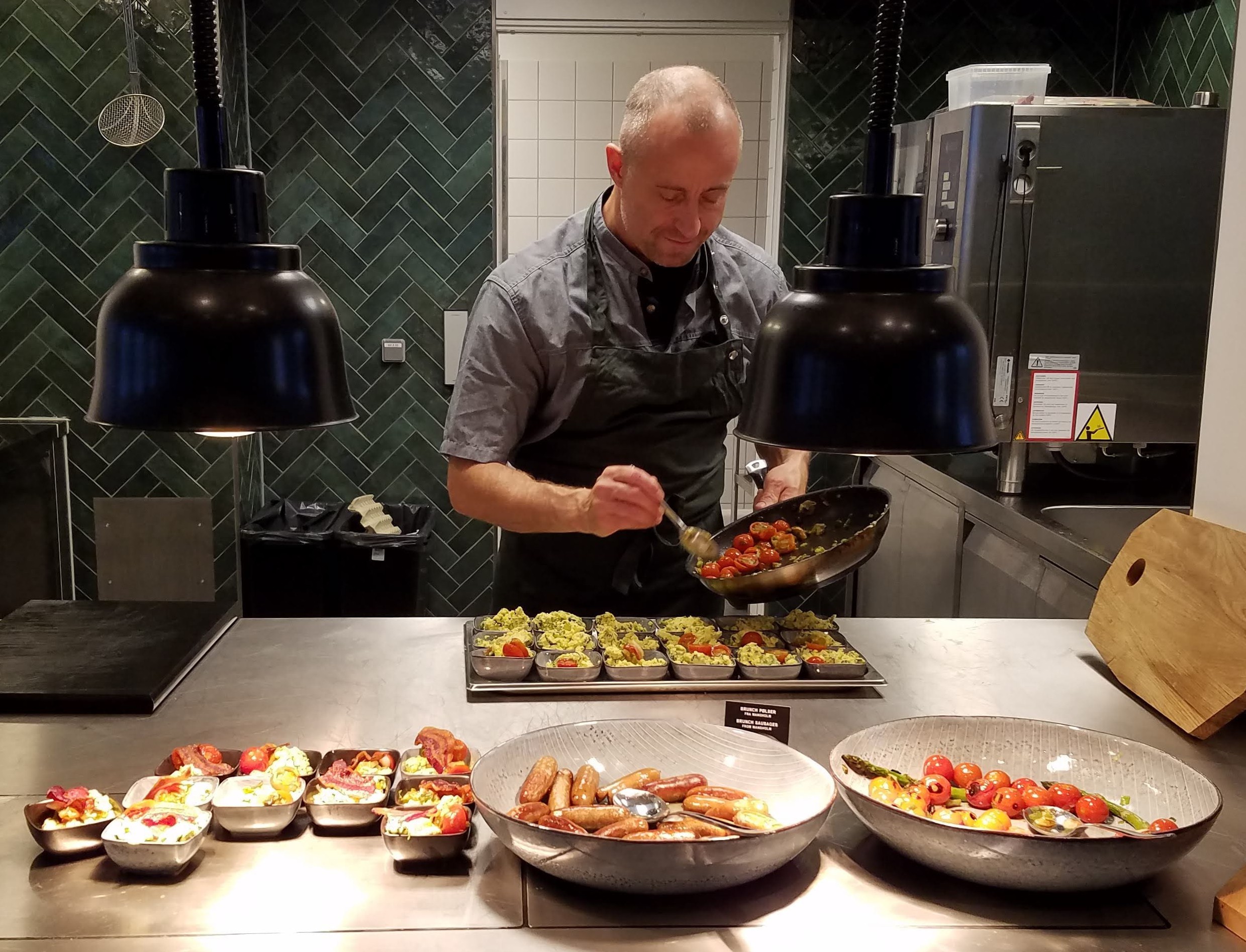
Breakfast chef
Nancy’s resolve to eat nothing but cereal for breakfast this morning dissolved when we got to the dining room and saw the chef preparing little dishes of freshly cooked, herbed eggs with grilled asparagus and tomatoes. Michael had made no such promises and thus was spared any pangs of conscience as he helped himself to the eggs, plus yogurt, granola, fruit, and pastries from the buffet. He might have justified himself further had he remembered that today is Father’s Day in the U.S., but that didn’t occur to either of us until much later in the day.
About half of our Discovery XA group had left for the airport before breakfast. Those with flights later today or later in the week met in the hotel lobby at 9:00 a.m. to begin the forty-minute walk to the meetinghouse of the Church of Jesus Christ of Latter-day Saints in Frederiksberg, a first-ring suburb northwest of central Copenhagen. The route took us across the Søerne (The Lakes) and then through less “touristic” commercial districts and residential neighborhoods. Not many people were out on the street around 9:15 on a Sunday morning, but it was refreshing to see some ordinary residents going about their ordinary lives.
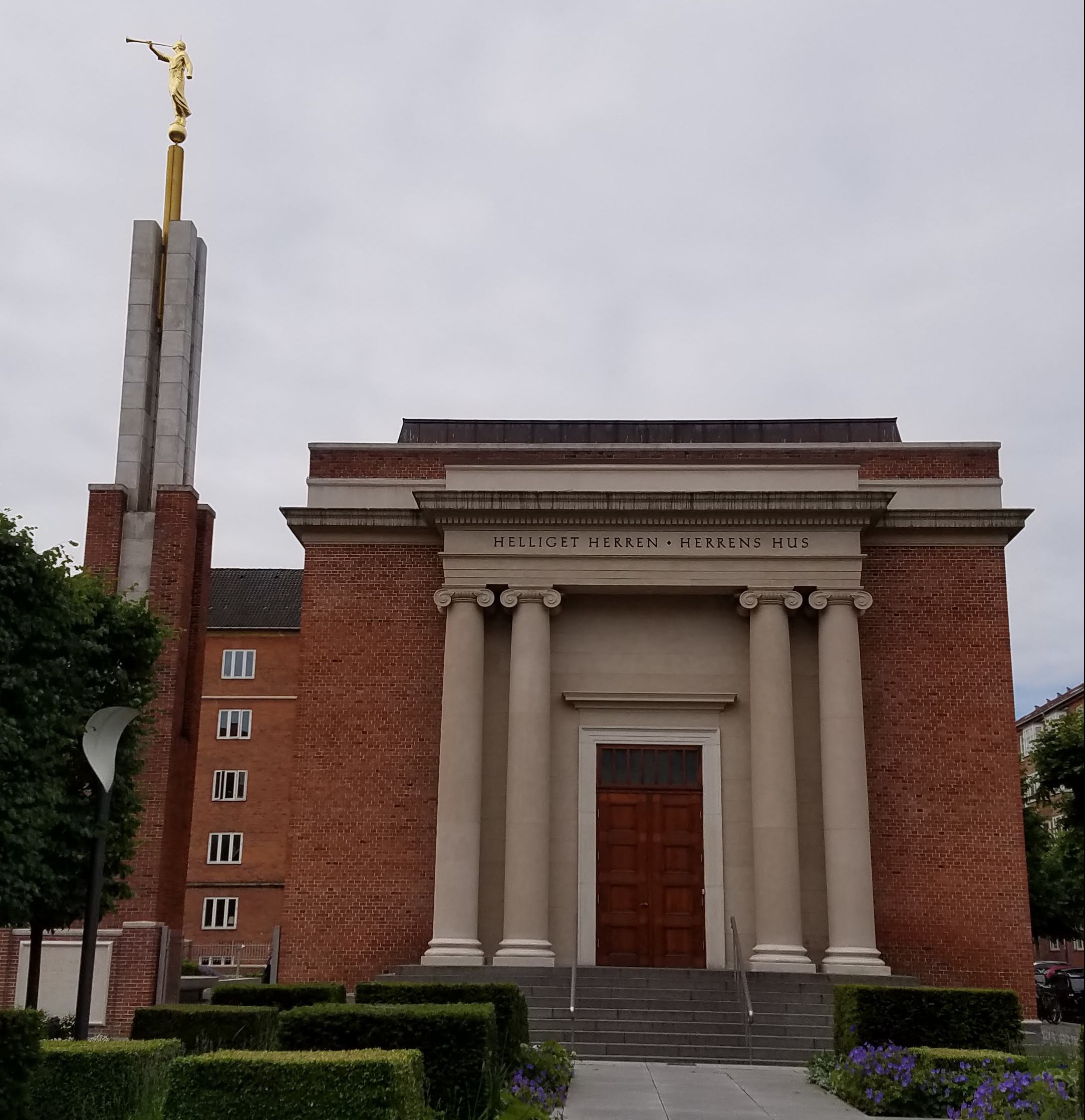
Copenhagen Temple of The Church of Jesus Christ of Latter-day Saints. The inscription reads: “Holiness to the Lord – The House of the Lord”
We knew we were close to our destination when we could see the golden figure of Angel Moroni atop the spire of the Copenhagen Temple. This red brick building is neither as big nor as grand as many LDS temples, having begun its life as a simple meetinghouse. The original structure was constructed in 1931, eighty years after the first LDS missionaries arrived in Denmark. During World War II, it served as a bomb shelter, but suffered no damage. In 1999, just after the Church announced plans to build smaller temples in more locations around the world, the Frederiksberg building was earmarked for extensive remodeling so that it could become a temple, and was dedicated as such in 2004.
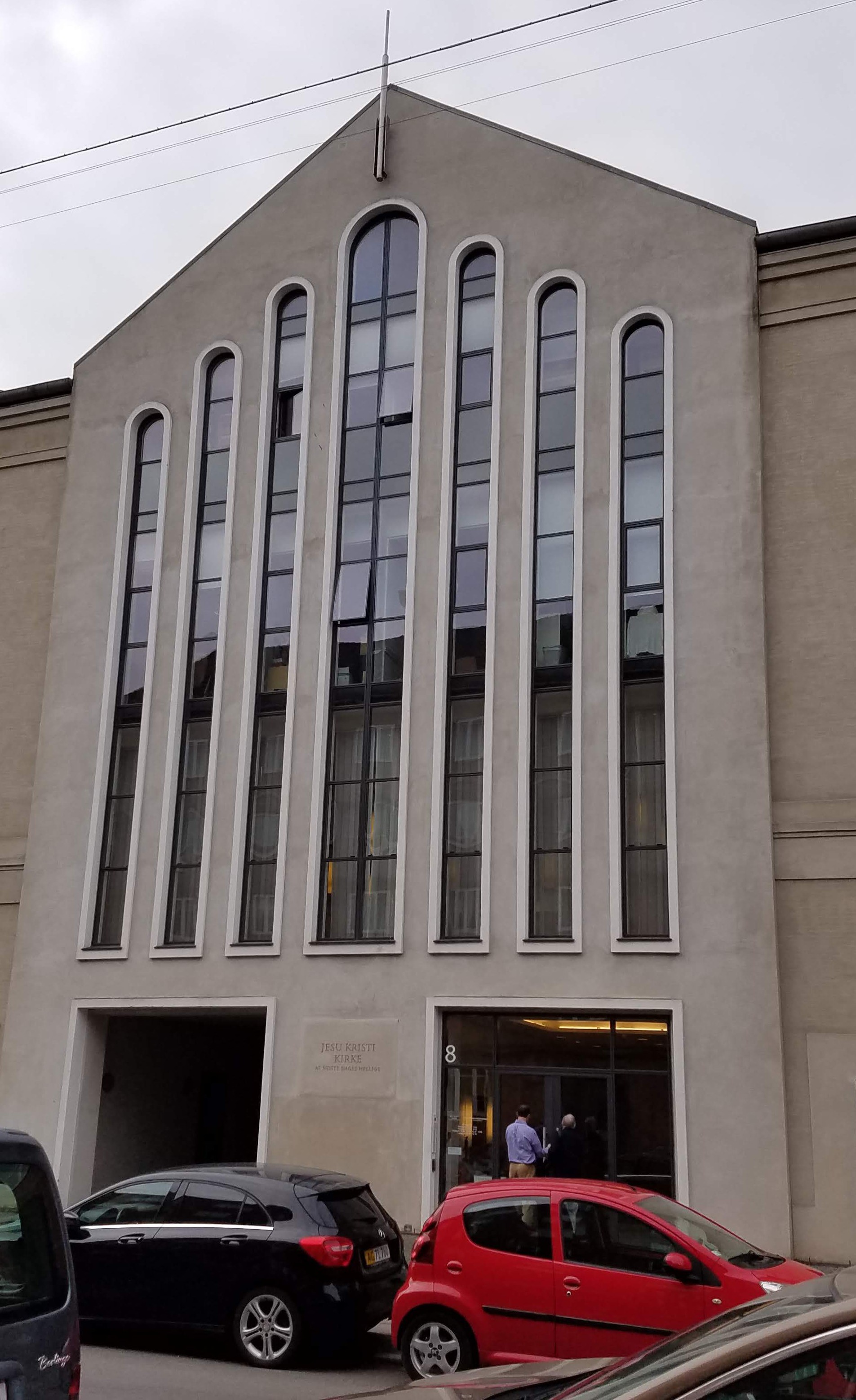
The Church of Jesus Christ of Latter-day Saints, Frederiksberg Ward
The meetinghouse where we would attend services this morning occupies one segment of a mixed-use row house in the block behind the temple. Unlike most LDS buildings in the U.S., there is no parking lot, because most Danes either use public transportation or ride their bikes. Even the temple, which draws visitors from all over Denmark, has only six parking spaces.
In the ground-floor foyer of the meetinghouse, we saw the wax model for Emigrants, a bronze monument by American sculptor Dennis Smith that stands in Rebild National Park in northern Jutland. The sculpture is dedicated to the nearly 18,000 Danes who converted to the Church of Jesus Christ of Latter-day Saints and then emigrated to Utah during the last half of the nineteenth century—a number that includes Nancy’s great-grandparents and the forebears of a few other members of our tour group. The sculptor also is a descendant of Danish emigrants; he served a mission here during the 1960s and later studied at the Danish Royal Academy of Art, so he feels a deep connection to the land and its people.
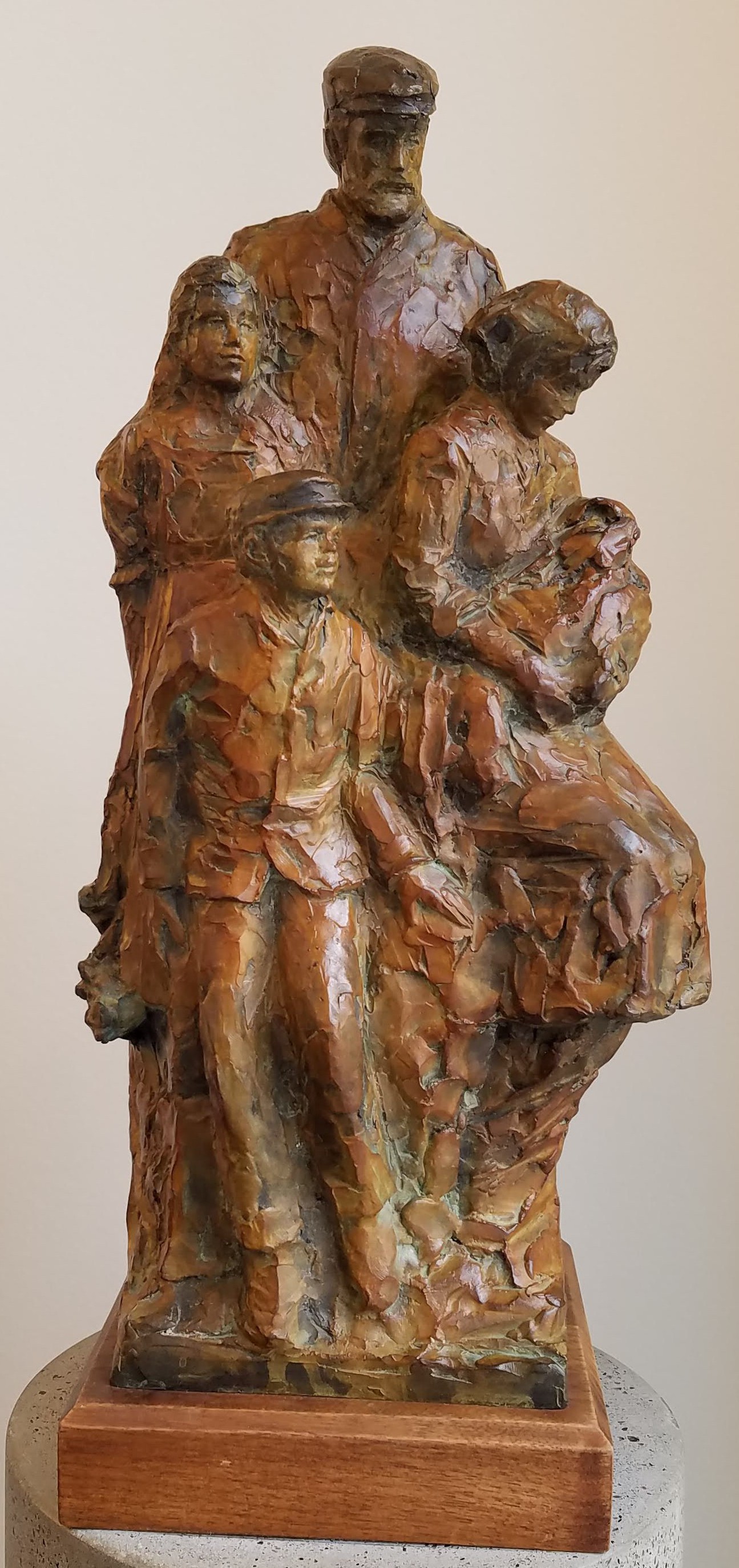
Wax model for “Emigrants” by Dennis Smith
The Frederiksberg Ward’s chapel is located on the second floor of the building, which is where we were welcomed by our friends Todd and Tara (a.k.a. Elder and Sister H.), who are currently serving as missionaries here in Copenhagen. We had met them when the four of us were freshmen at Brigham Young University, all living in the same dorm complex and attending the same church congregation, but neither couple became a “couple” until our college years were nearly over. The four of us hadn’t seen each other for decades, so we have been looking forward to this opportunity to reconnect and reminisce.
Tara had told us that the Frederiksberg Ward offers English translation for its services every Sunday because they get so many international visitors, and she advised us to arrive early to make sure we could get headsets before they ran out (as happened a couple of weeks ago). We didn’t need the headsets for one of the sacrament meeting talks, which was given in English by an American woman who spoke about how faith in God can motivate us to action. The other speaker’s subject was the importance of having faith in ourselves. He looked over the congregation and said, “I want you to know that you’re doing OK”—an interesting message coming from a man who looked like he was under 30, but who nevertheless holds a significant leadership position as a member of the Church’s regional High Council. We didn’t need headsets for Sunday School, either, because there was a class taught in English by a woman from New Zealand; she led a good discussion on how we as individuals can make partaking of the sacrament a more meaningful experience.

Café Delight
When the meetings were over at noon, we made arrangements to meet Tara and Todd for dinner this evening, said goodbye to departing friends from our tour group, and then walked back toward the main street where the temple is located. A pair of young missionaries helped us find the ATM next to the Italian restaurant that Tara had told us about, and then showed us where to catch the 4A bus that would take us into central Copenhagen. But we weren’t ready to leave Frederiksberg yet. We had a lunch date at Café Delight (located across the street from the local Aldi as well as the temple) with Nancy’s cousin Knud, who lives about twenty minutes farther west in the second-ring suburb of Albertslund.
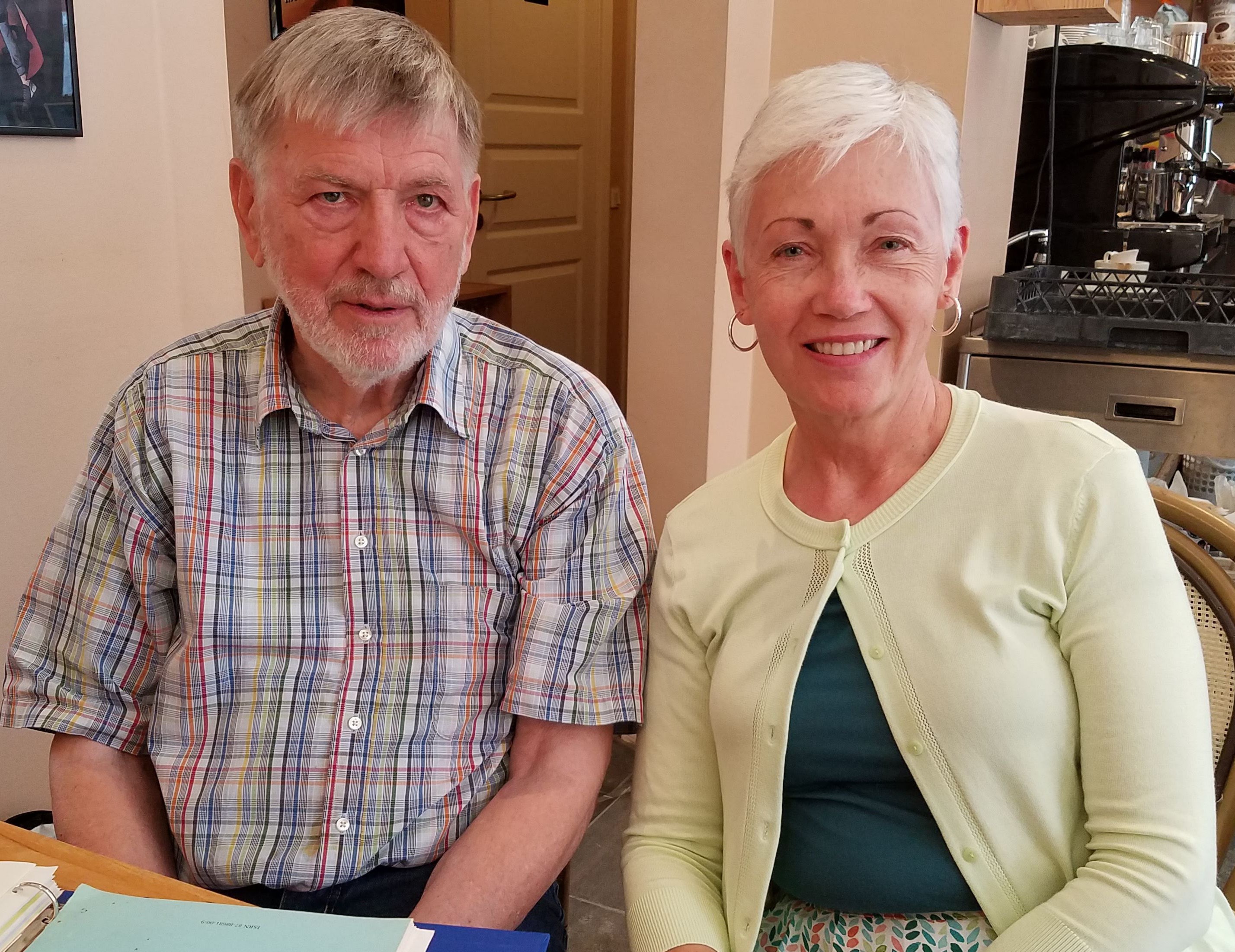
Knud and Nancy. Do they look like cousins?
Actually, Nancy and Knud are fourth cousins, so their blood relationship is distant, but they became acquainted after Knud ran across a blog post from our 2017 trip to Denmark while researching one of their common ancestors, and left a comment that included his email address. Since then, they have corresponded frequently, sharing photos and documents to help each other create a more complete and accurate history of their forebears.
Today, Knud brought along an album with photos and memorabilia of his great-great-grandfather, Peder Pedersen Bertelsen (the uncle of Nancy’s great-grandmother), who had traveled to Paris in 1867 for the Exposition Universelle (World’s Fair) and won a bronze medal for the fishing dragnets he had invented. Nancy followed up by showing Knud how easy it is to access pedigree charts and photos of ancestors using the FamilySearch app on her phone. Michael responded by suggesting that we probably should go up to the counter and order lunch.
Back at the table with our bagel sandwiches, Michael tried to ease the conversation away from the deceased and on to the living. “What kind of work did you do in your career?” he asked Knud, who turned 80 this year.
Knud declined to respond right away, saying simply: “Eat first, then talk.” (We have since learned that this is a very Danish thing to do: save conversation until the business of eating has been completed.)
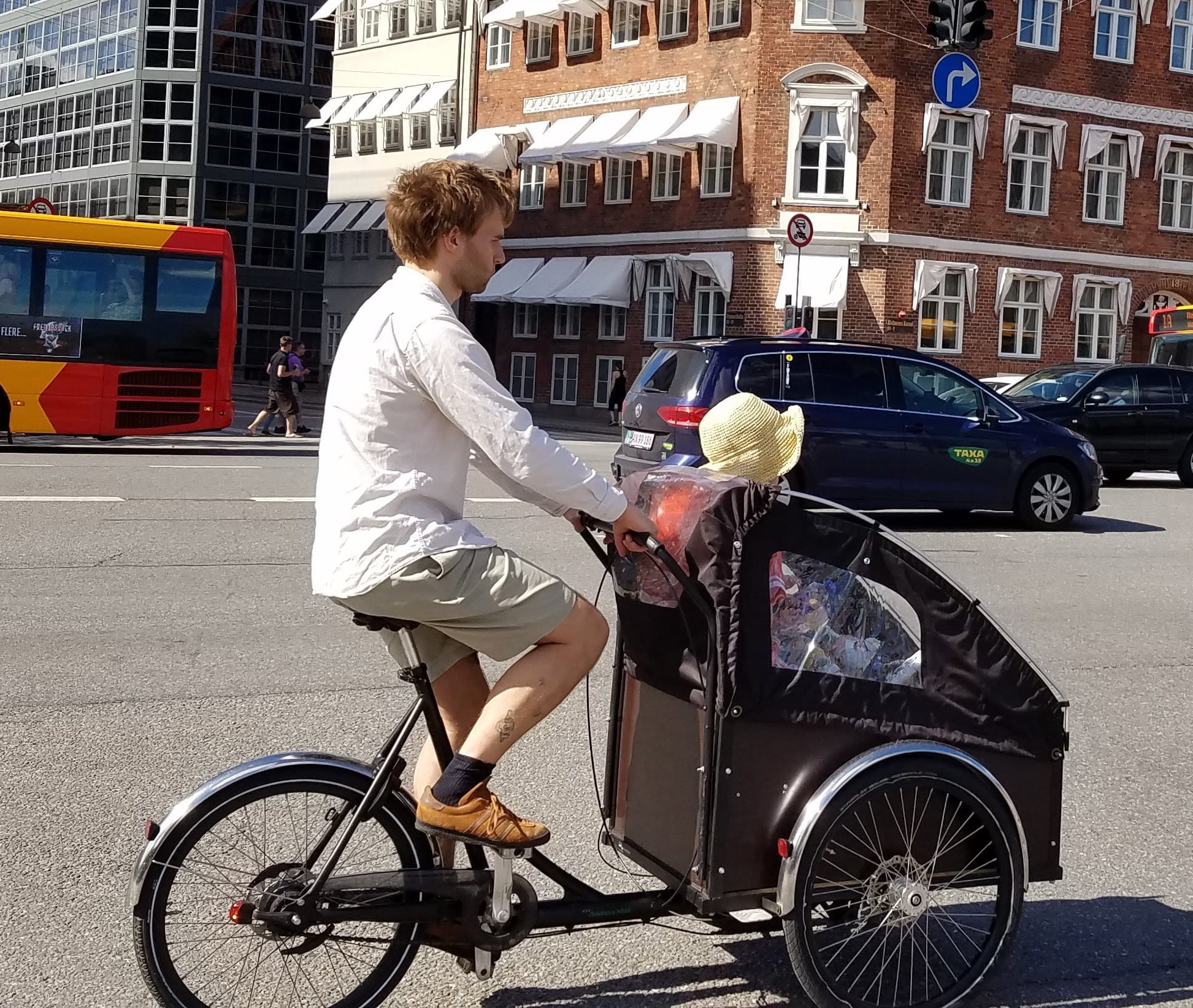
A father on a Sunday afternoon drive with his children
When all that was left of our sandwiches was crumbs, Knud told us that he had been an electrical engineer at a company that makes technical measuring equipment. Since retiring, in addition to his family history research, he has devoted much of his time to the study of botany. In fact, when we parted after lunch, Knud was going to a special exhibition at a botanical research garden near his home, for which he had helped to gather specimens during the past week. We were grateful that he took the time to meet us today, and Nancy is particularly grateful for the family information he has shared.
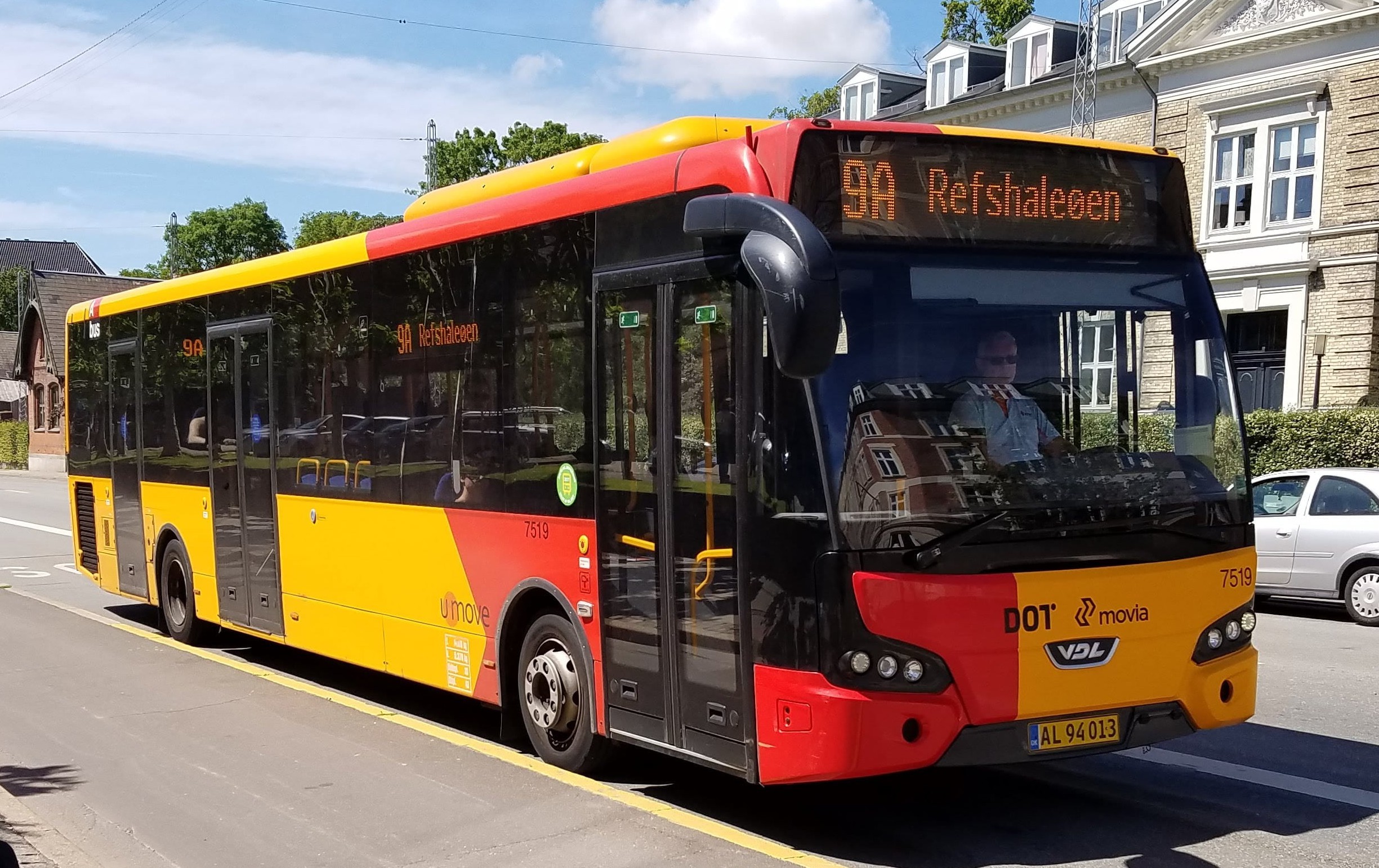
9A bus
The stop for bus 4A was only a block from Café Delight, so we hopped on and then transferred to the 9A, following the directions Tara had given us to get to the Thorvaldsen Museum in Copenhagen’s historic center.
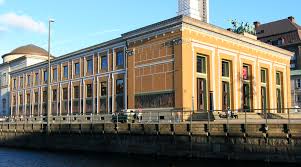
Thorvaldsen Museum
The prominent location of the Thorvaldsen Museum next to Christiansborg Palace is emblematic of Bertel Thorvaldsen’s place in Danish culture. This is the oldest museum in Denmark, begun in 1838 to house the sculptor’s working models, sketches, and personal art collection. Funds for the building were contributed by the Danish public, who still regard him as a national hero.
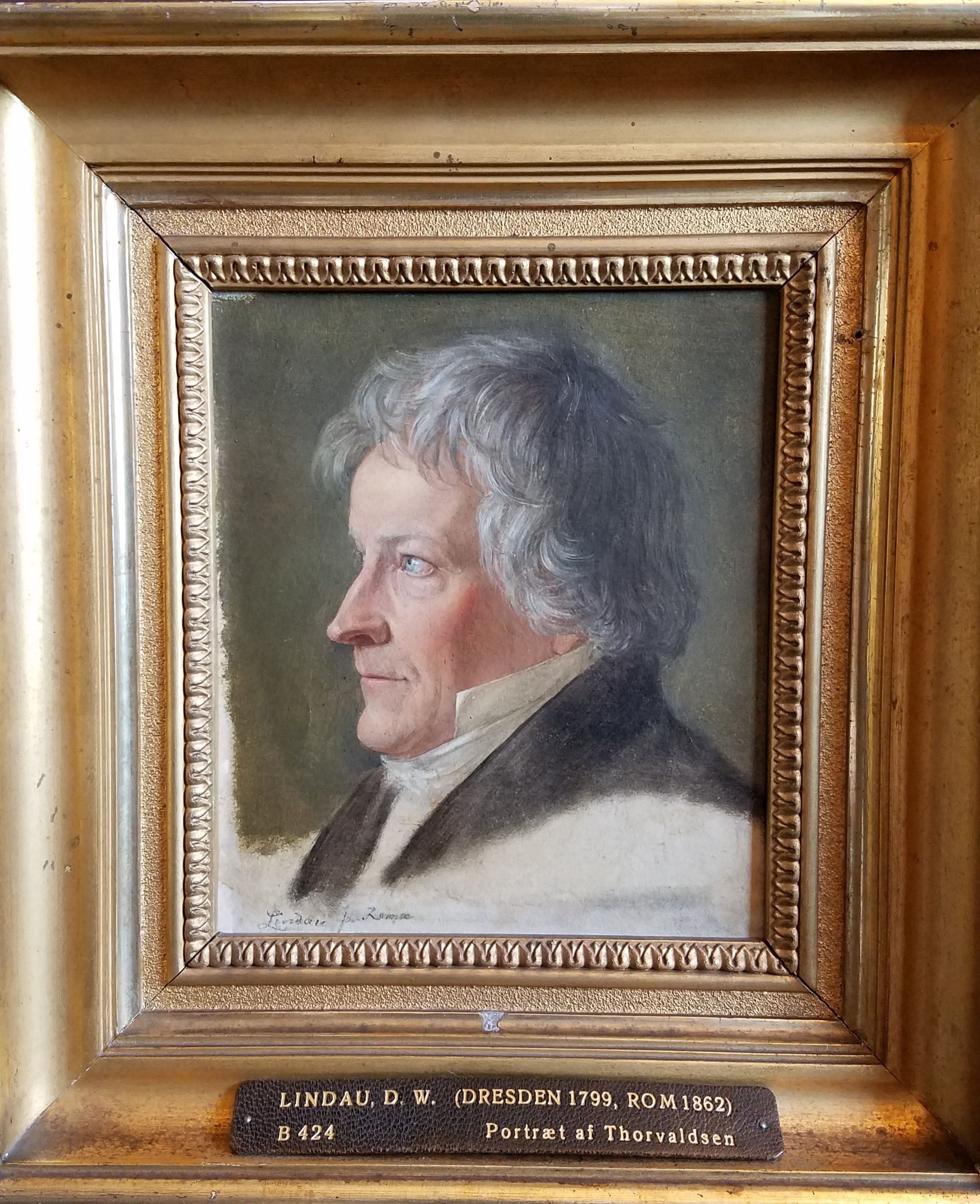
Portrait of Thorvaldsen
Thorvaldsen was trained at the Royal Danish Academy of Art but went to Rome as a young man after winning a royal stipend to further his art education. He spent most of his working years in Italy and became renowned throughout Europe for his neoclassical sculptures, which echoed the style of ancient Greece and Rome. Kings and noblemen engaged Thorvaldsen to create heroic monuments to themselves, while governors and clergymen commissioned him to decorate public buildings and churches.
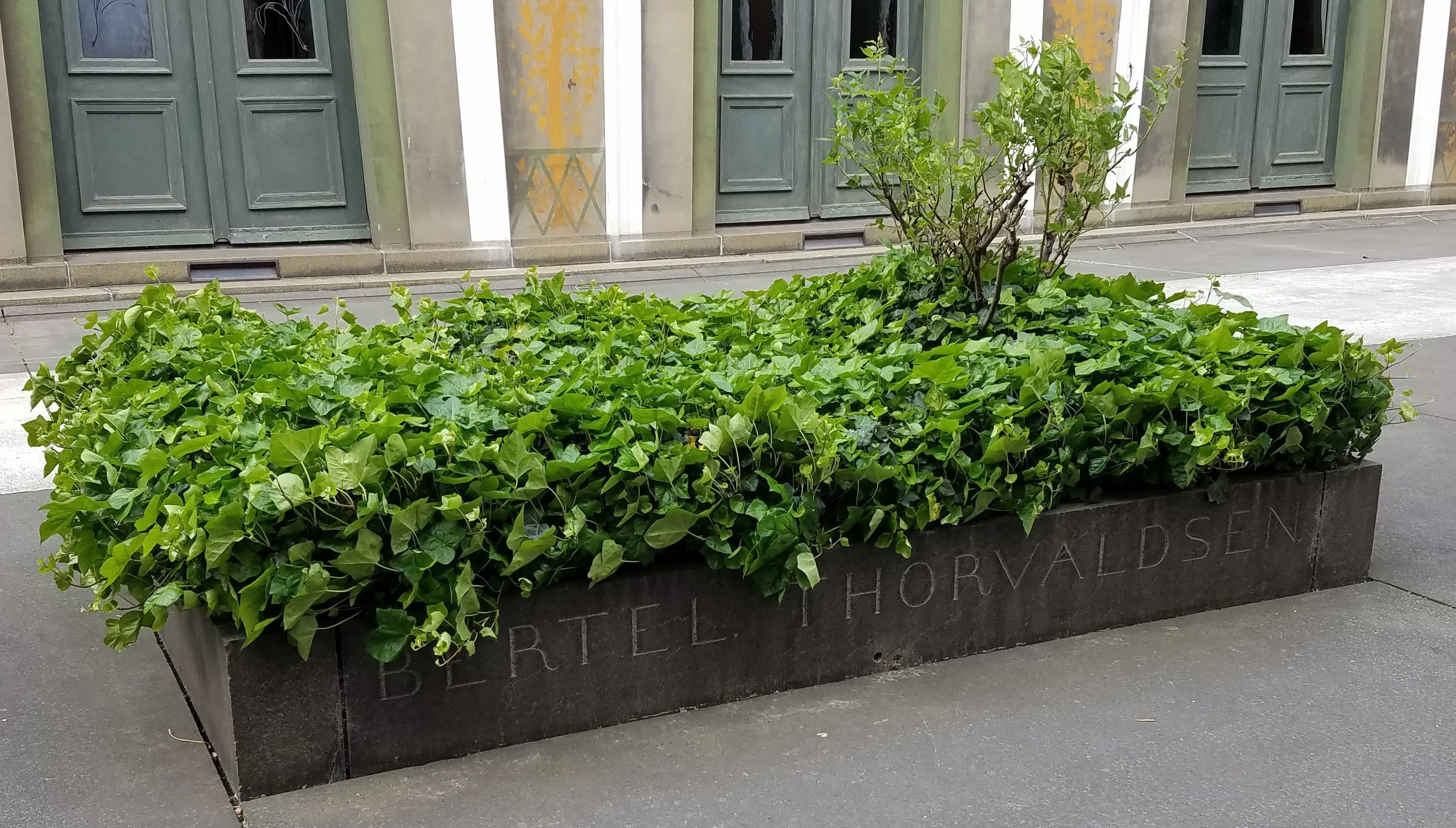
Thorvaldsen’s tomb
He returned to Denmark in 1838 to oversee the installation of the completed statues of Christ and the Twelve Apostles in Vor Frue Kirke, and then remained in his native land until his death in 1844. He is entombed in the museum’s courtyard.
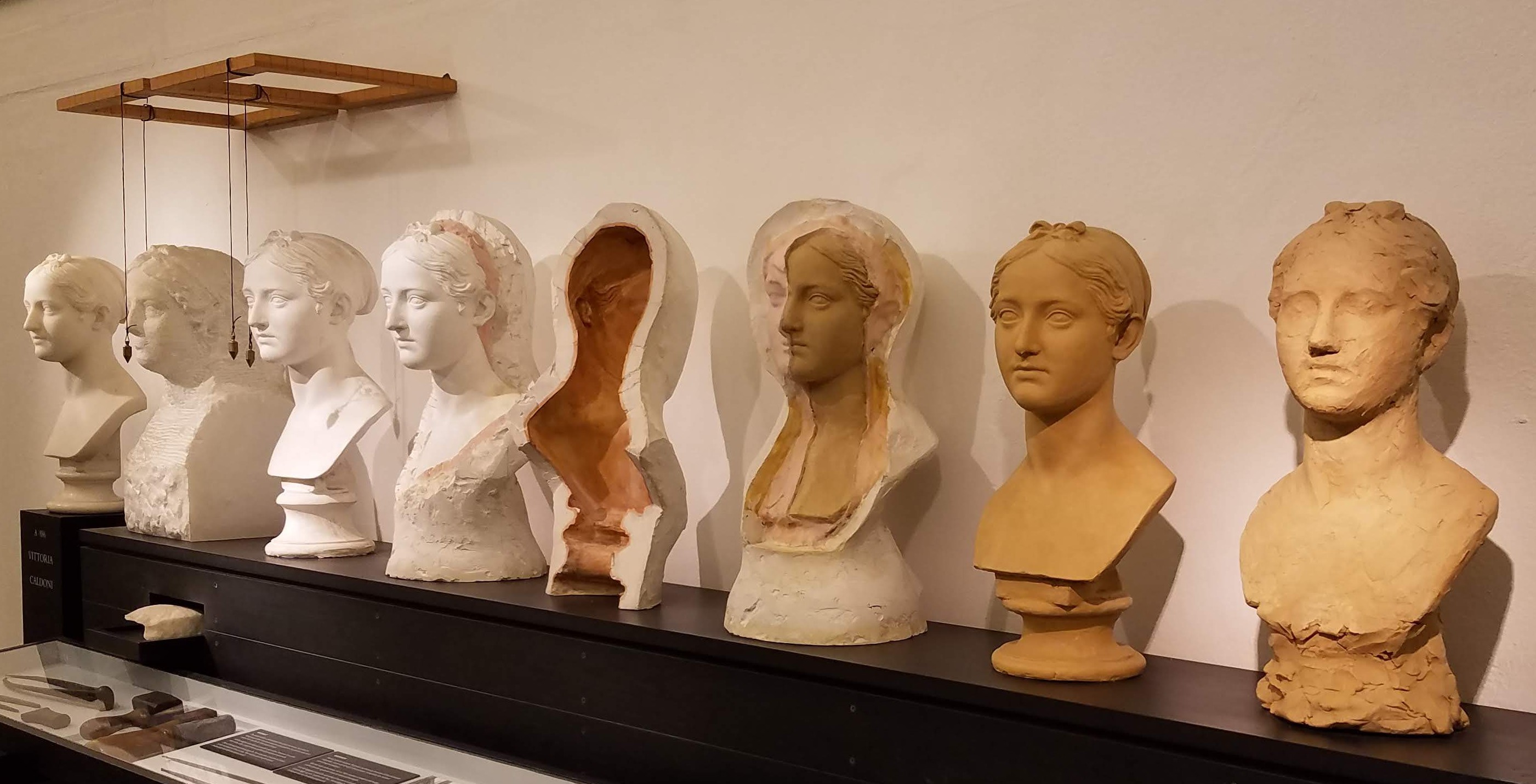
From right to left, beginning with terra-cotta: models representing the process for creating a marble sculpture
Wandering the galleries of this blessedly uncrowded museum turned out to be the perfect way to spend a Sunday afternoon. While cool neoclassical marbles are not necessarily our favorite type of artwork, we were interested to learn exactly how such sculptures are created, and could appreciate the technical and aesthetic skills needed to produce them.
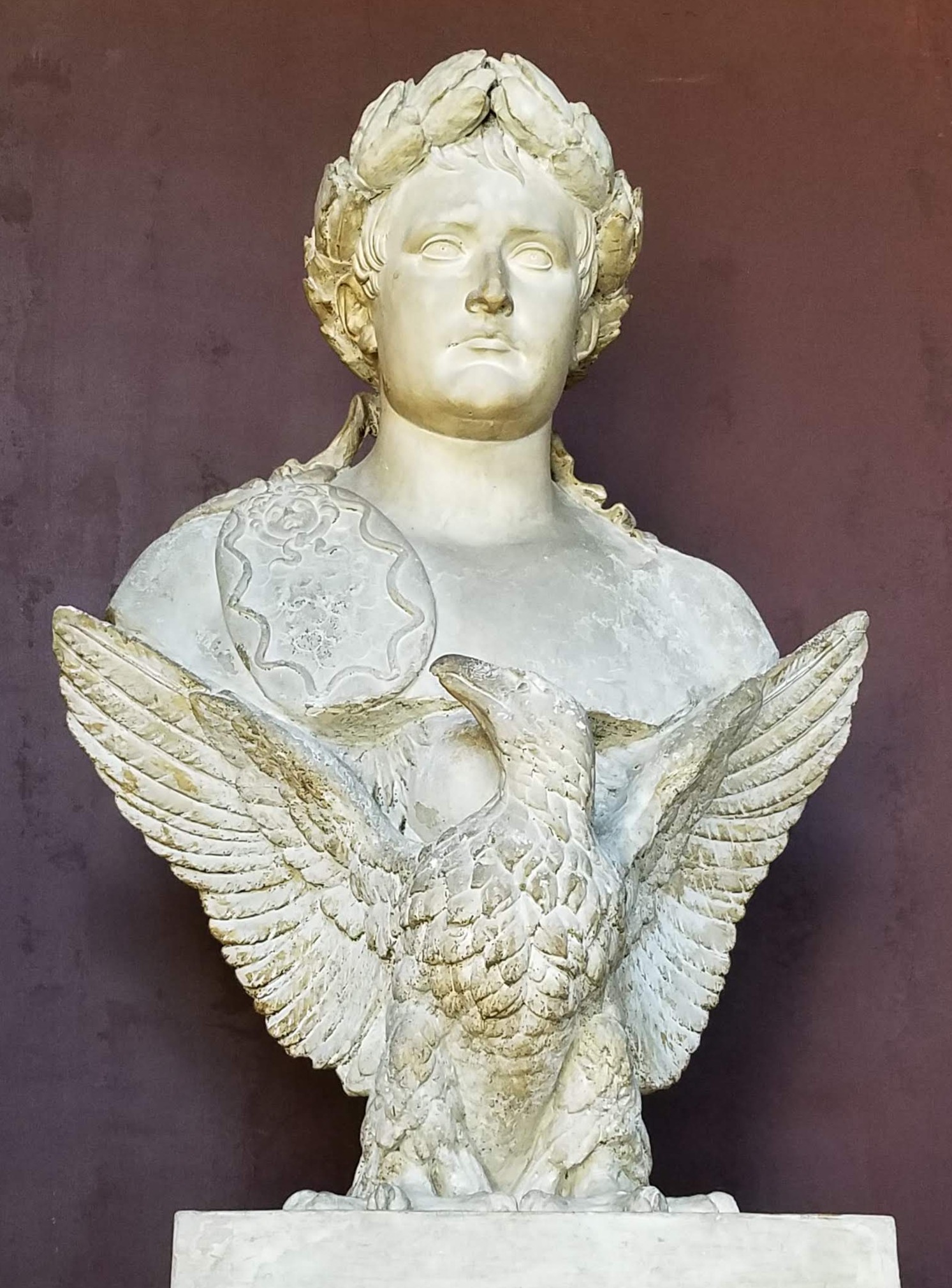
Napoleon Bonaparte
The subjects of most of Thorvaldsen’s work—other than statues and busts of his wealthy patrons—are drawn from Greek and Roman mythology, with the notable exception of the sculptures he made for Vor Frue Kirke. We did not realize until today that that commission also included a group for the pediment over the church’s entrance, entitled “John the Baptist Preaching in the Desert.” At the museum, we were able to examine the plaster models for those sculptures and were captivated by the way Thorvaldsen portrayed the various reactions of the people listening to John’s message.
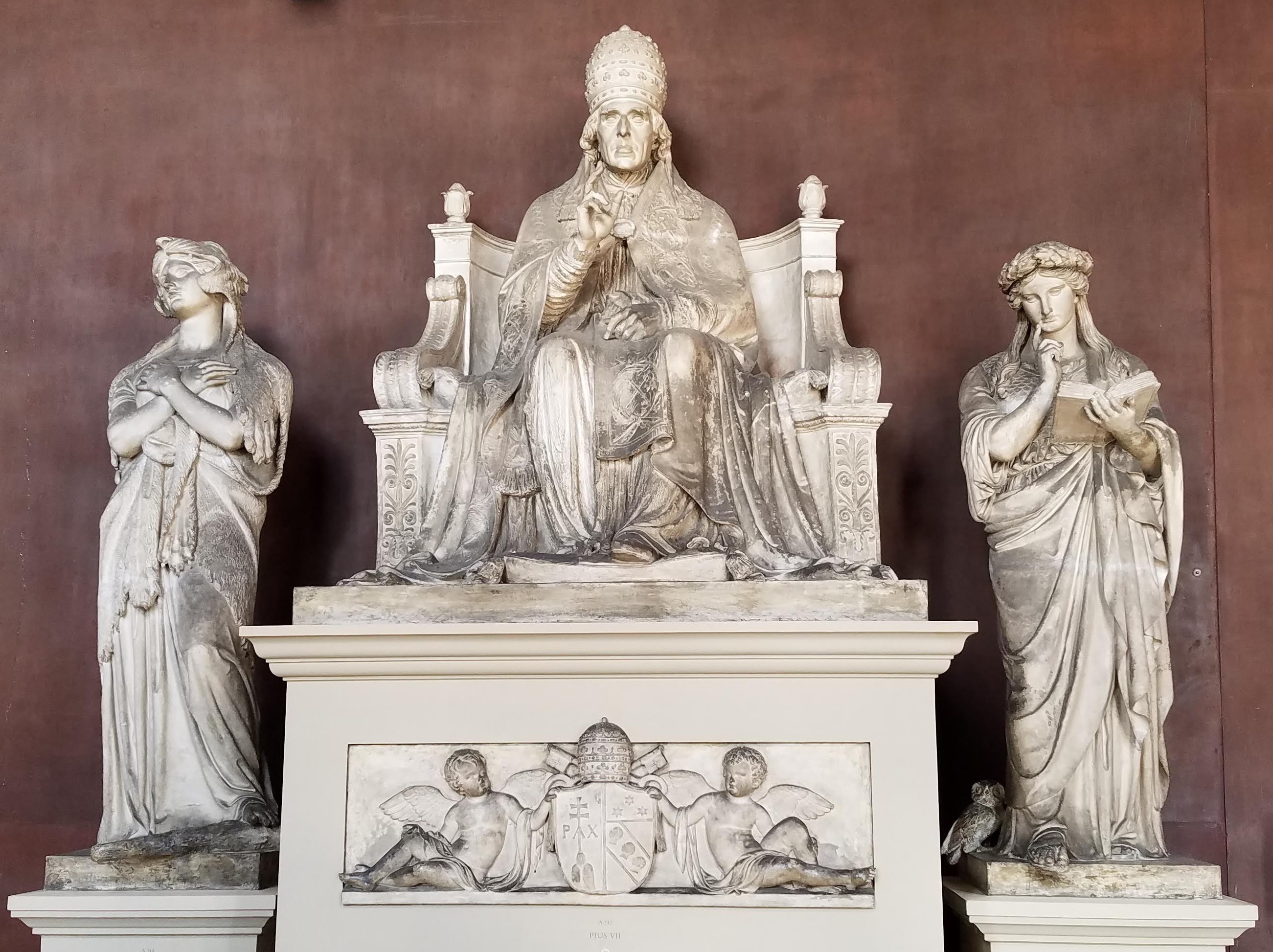
Model for the tomb of Pope Pius VII, the only sculpture by a non-Catholic in St. Peter’s Basilica in Rome
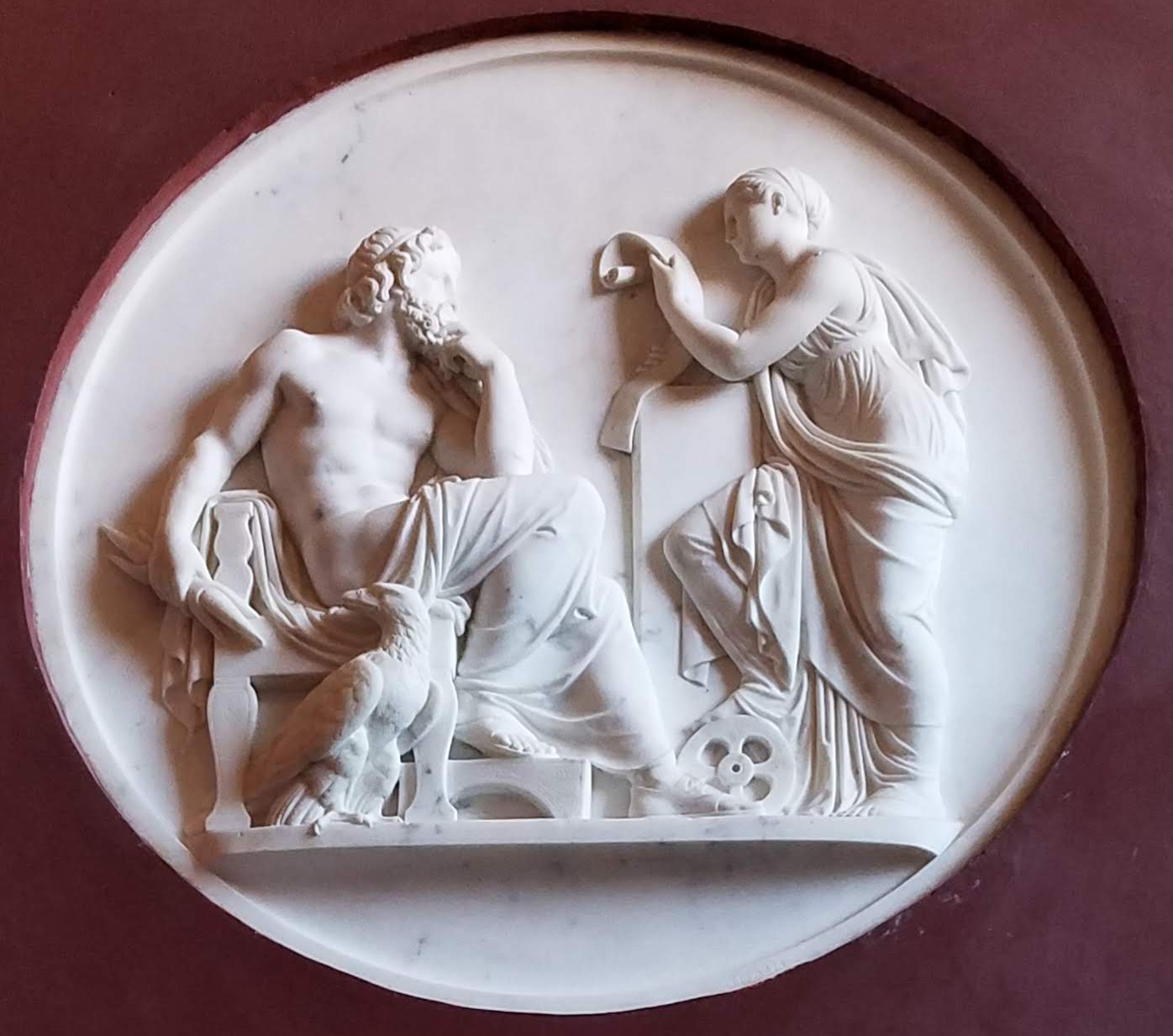
Nemesis, the goddess in charge of punishing the proud and arrogant, reads Jupiter a list of humans in need of chastisement
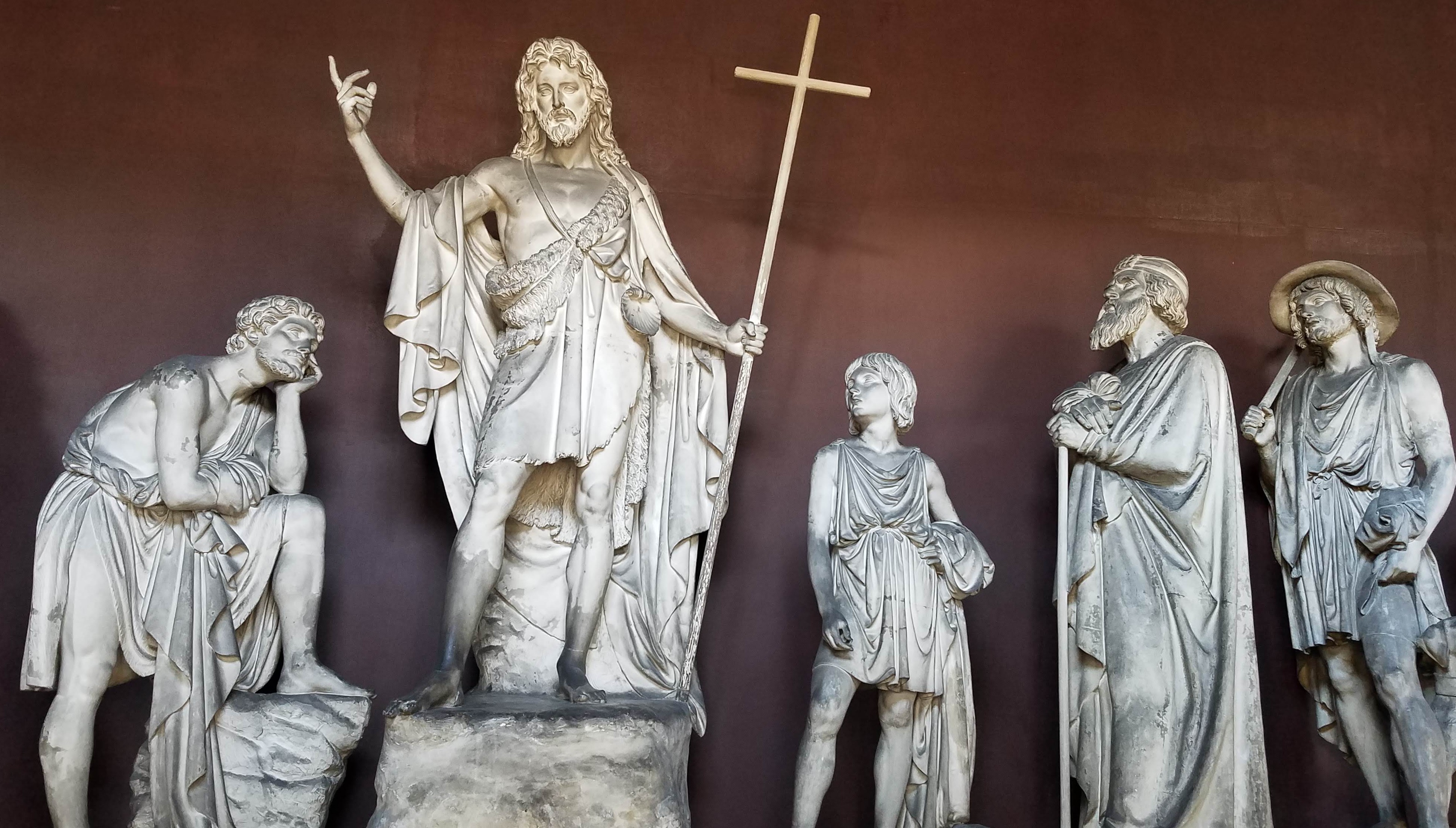
Plaster models for the central figures of “John the Baptist Preaching in the Desert”
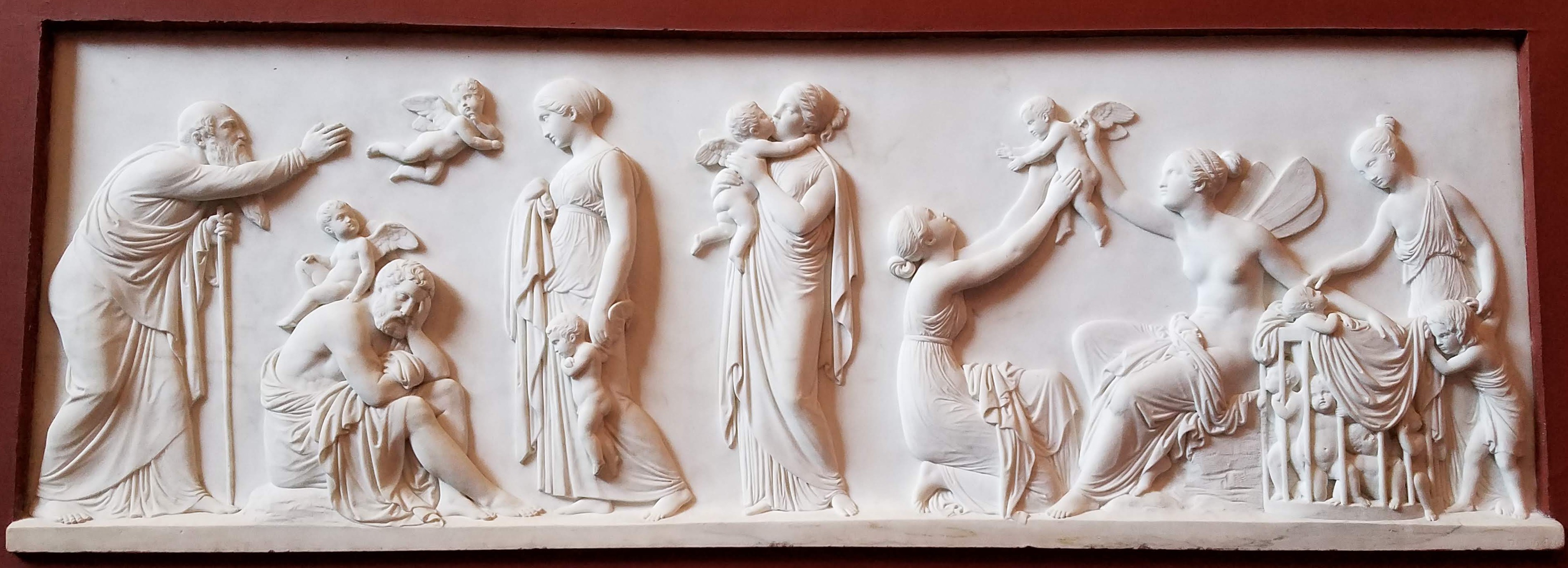
“The Ages of Love” depicts the changing ways humans experience love (represented by the winged cherubs) during our lives
The upper floor of the museum contains Thorvalden’s personal collection of books, antiquities, and works by other artists. The successful sculptor assisted several of his colleagues by purchasing their paintings and recommending them to his own patrons. One piece that Nancy especially liked was a landscape that reminded her very much of Denmark’s Nordfjends region, where her Bertelsen ancestors had lived.
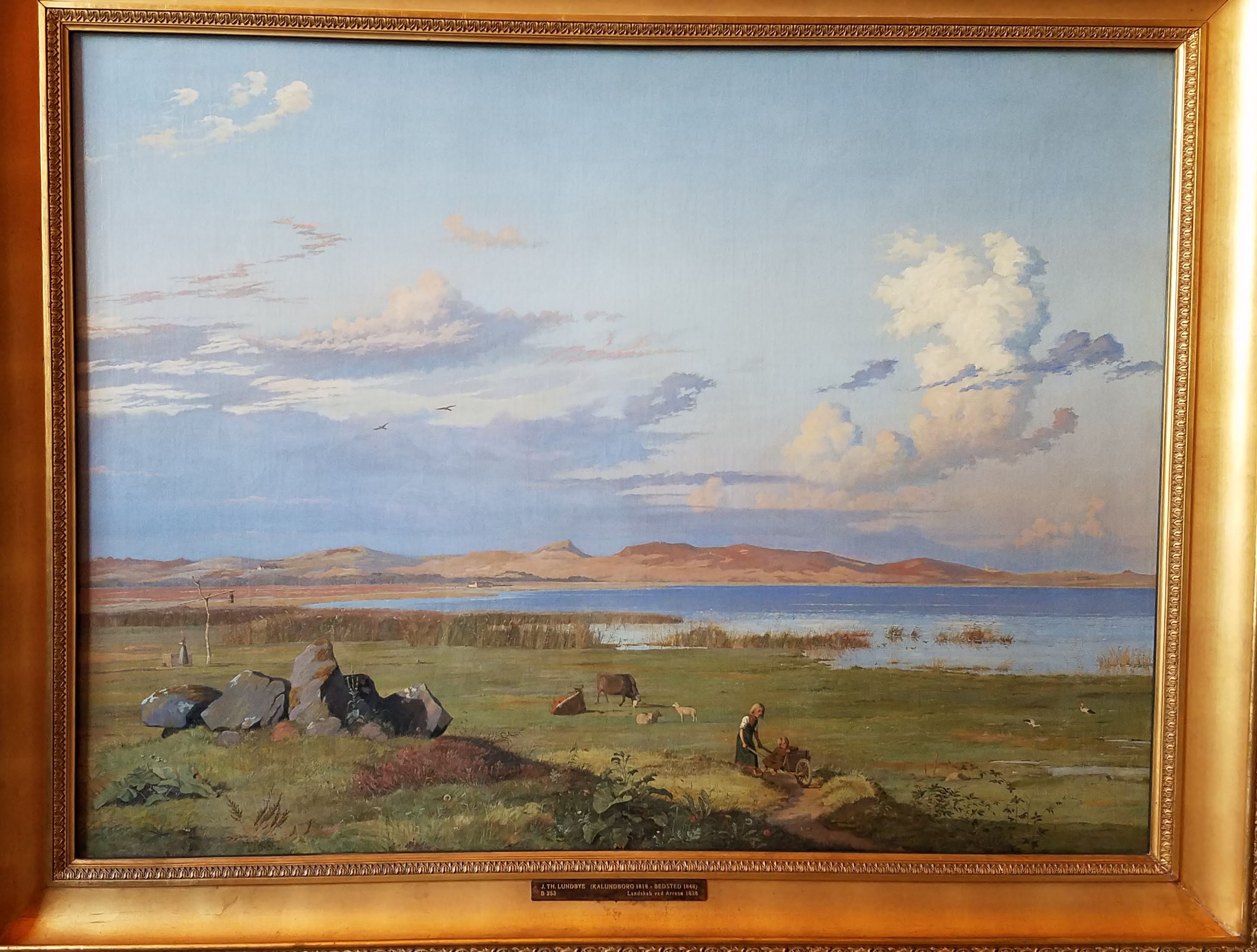
Landscape by Johan Thomas Lundbye (1818-1848). The artist was fatally shot only a few days after enlisting in the Danish army during the first Schleswig War.
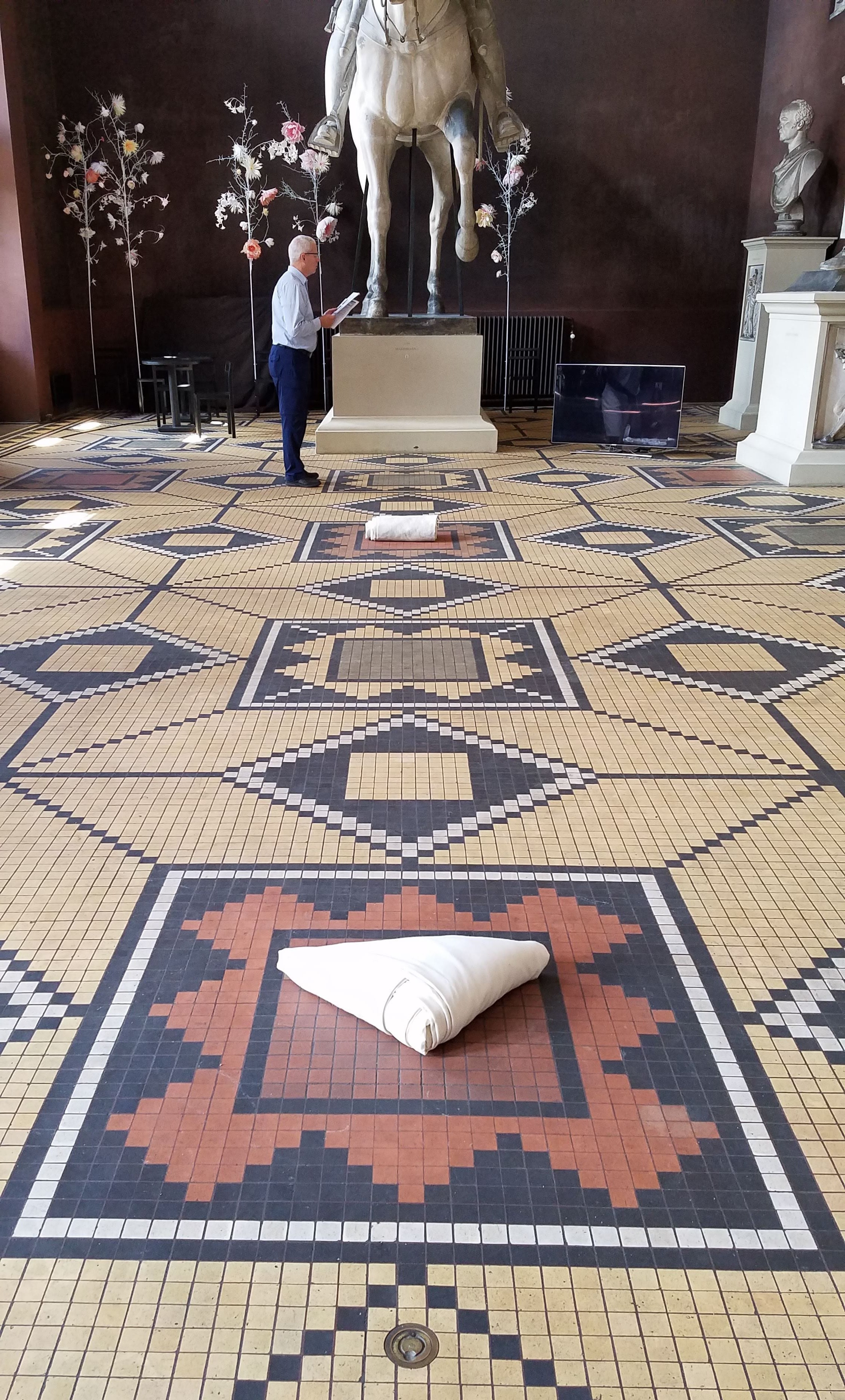
The blossoming trees and the canvas bundles on the floor of this gallery are part of a temporary art installation meant to harmonize with Thorvaldsen’s sculptures
Earlier this afternoon, as we crossed Bertel Thorvaldsens Plads (Plaza) toward the museum entrance, we had been puzzled by some odd white drapery hanging irregularly over the roof. Then, while gazing upward upon entering the first large gallery, Nancy suddenly tripped over a bundle of heavy white canvas lying in the middle of the floor. It wasn’t until we started watching a silent video presentation going on in the same room that we realized the white drapery outside and the white canvas bundle inside were part of a current exhibition of installations and performance art called “This Moment Is the Beginning.”

The bundle Nancy accidentally tripped over
More peculiar pieces in white appeared throughout the museum: white leaves raked into a pile on the floor, white panels hiding a doorway, white gauze shrouding a bust, white potsherds scattered next to Thorvalsen’s tomb. We weren’t quite sure what it all was supposed to mean, even after reading the artists’ notes in a brochure—maybe especially after reading the artists’ notes. (After long experience editing books by painters, sculptors, and designers, Nancy will tell you that most visual artists are wise to express themselves through media other than words.) But we applaud the curators of the Thorvaldsen for adding some contemporary art to entice visitors back into a museum with an otherwise static collection.
Shortly before 5:00 p.m. we were back on a bus, heading toward our dinner appointment with Todd and Tara. It turned out that we had passed close by their apartment last night on our way to Restaurant Cofoco. They live just off the southwest corner of Sankt Jørgens Sø (one of The Lakes), in a building where the Church maintains a few units for some of its senior missionaries. We were not Todd and Tara’s only dinner guests this evening; two of Todd’s sisters have been visiting them this week, too, on their way back from a trip to Russia.
“I wanted to serve you something typically Danish tonight,” said Tara, “but then I didn’t have time to make frikadeller [meatballs] liked I’d planned, so we’re having good old American chili. I hope you don’t mind.”
Actually, we were thrilled. It had been weeks since we’d eaten anything so reminiscent of home: steaming bowls of chili topped with shredded cheddar, sour cream, and tortilla chips; a platter of sliced tomatoes and crisp cucumbers; and a big bowl of grapes. Dessert was more typically Danish: parfait glasses layered with applesauce, crumbled ginger cookies, whipped cream, and nuts. We enjoyed the food, but even more we enjoyed the chance to talk, exchanging highlights from the past thirty years of our lives, and then hear about Todd and Tara’s current missionary assignment.
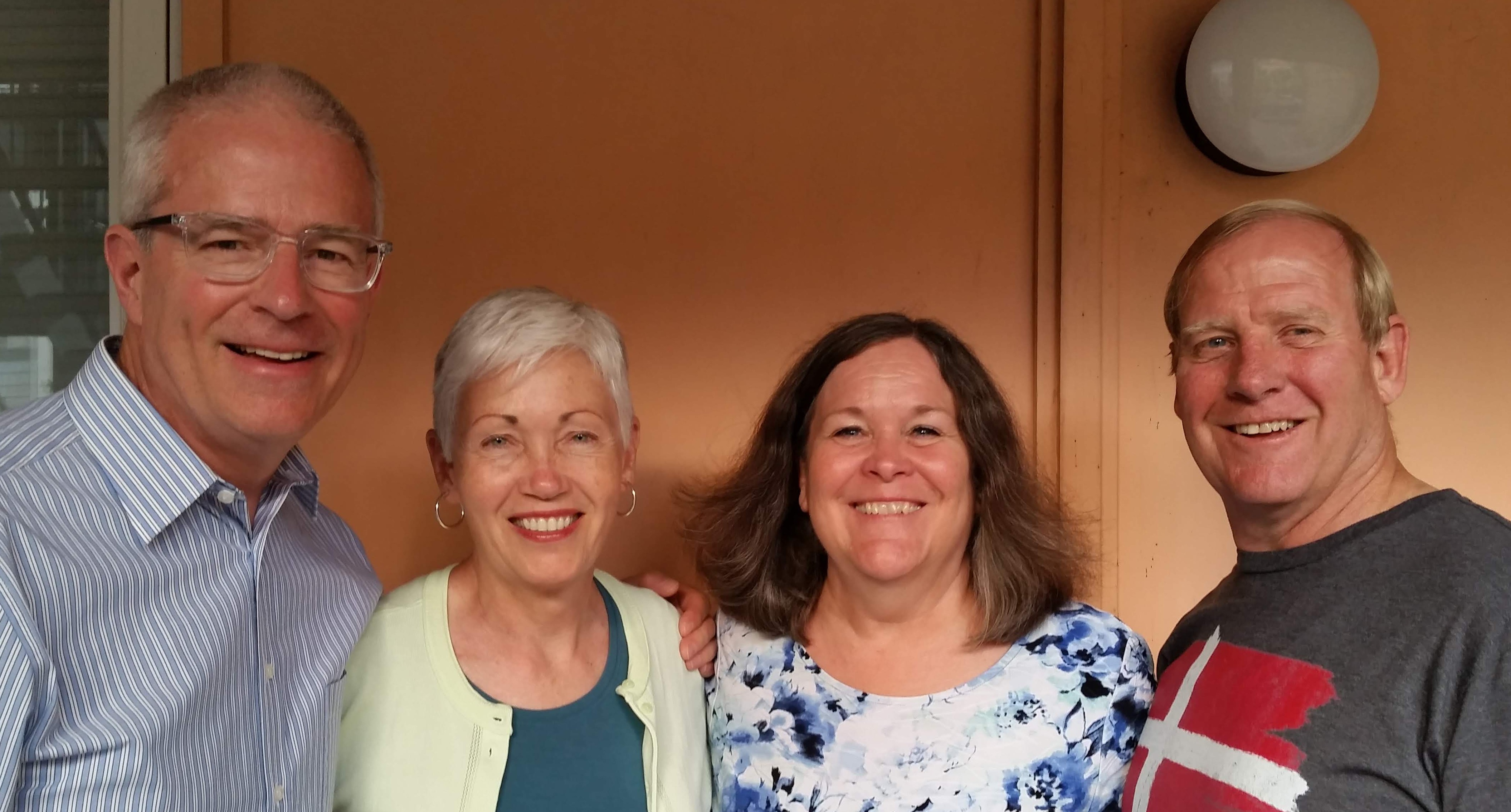
Old friends outside Tara and Todd’s apartment in the Vesterbro district
Elder and Sister H. serve as family history specialists in the Church’s Denmark Copenhagen Mission. Four days a week, they work in the national archives located within Christiansborg Palace, using specialized, high-resolution cameras to photograph handwritten parish records so they can be digitally indexed and made available for online research. Like Nancy, Todd has Danish ancestry and has done a lot of research on his own family, so he appreciates the importance of producing accurate digitized records for other researchers, and seems to be thriving on this opportunity to serve while continuing to learn about his own heritage. Producing a clear image of every page in an old record book is tedious, painstaking work, but Tara (who is not quite as passionate about this as her husband) says they can help the time pass more quickly by listening to music and podcasts through their earbuds.
Their other project has been learning to speak and read Danish. The Danish government requires at least one member of a married couple staying in the country for more than a year to pass a Danish language literacy test. Todd pulled the short straw for this couple and has studied a couple of hours each night to get ready for the exam. Tara has been working at it, too, but not as diligently as Todd because she doesn’t have to get tested. Both were relieved when Todd passed the exam a few months ago.
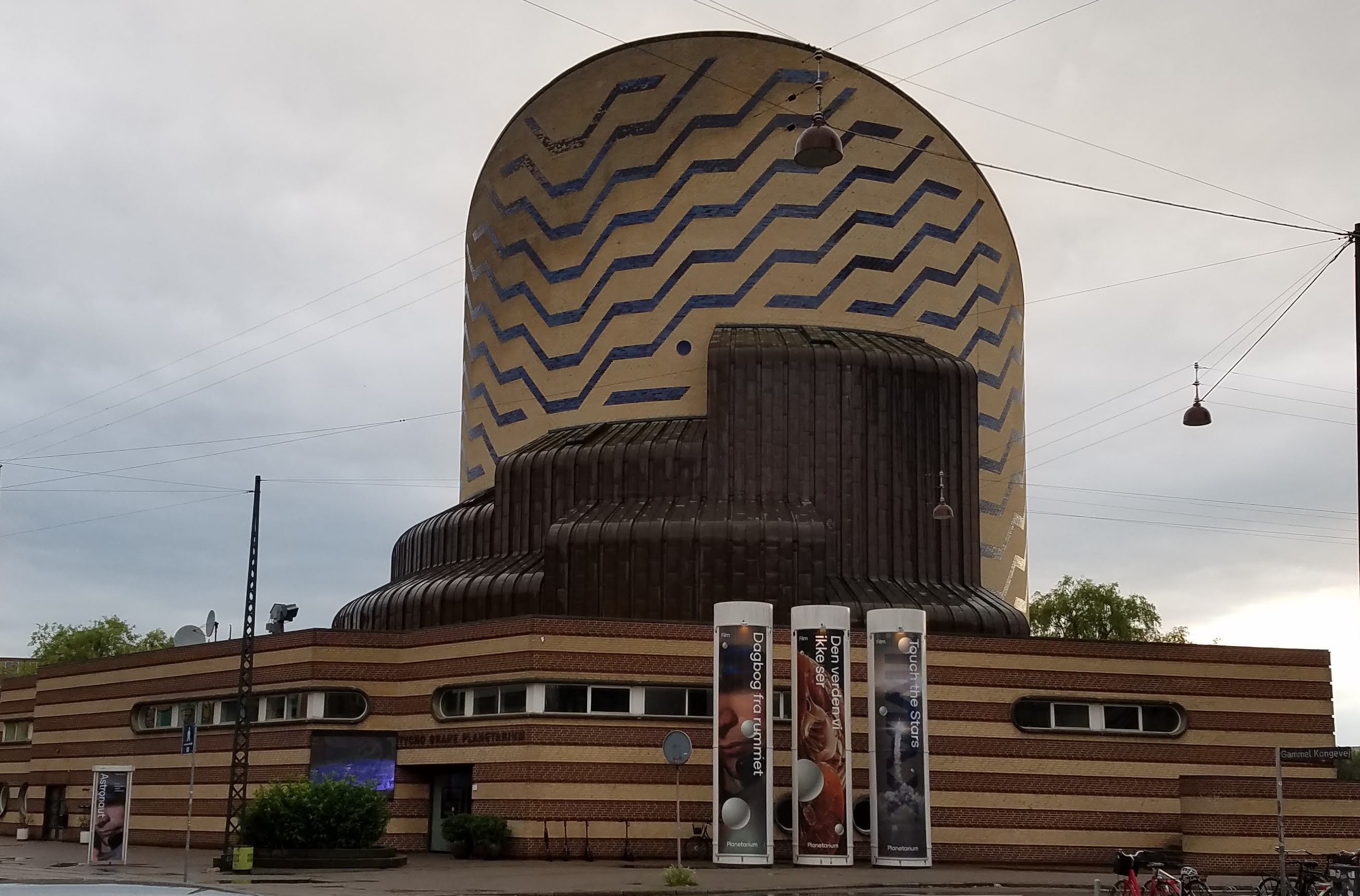
Tycho Brahe Planetarium
Serving as missionaries hasn’t been all drudgery for Elder and Sister H., however. They have made multiple trips all over Denmark to photograph grave markers, but they’ve also been able to visit museums, historic sites, and even fun places like Tivoli Gardens because they have Mondays as well as Saturdays and Sundays off work. We are really glad we had a chance to spend this evening with them.
On our walk back to the hotel, we passed a planetarium named after Tycho Brahe, the sixteenth-century Danish astronomer. Brahe made remarkably accurate calculations about the movements of heavenly bodies despite the fact that he had to work without a telescope (which Galileo invented a few years after his death). Brahe left Denmark after a falling out with King Christian IV and spent the last years of his life in Prague as the official astronomer in the court of Rudolf II of Bohemia, but the Danes still claim him as a native son.
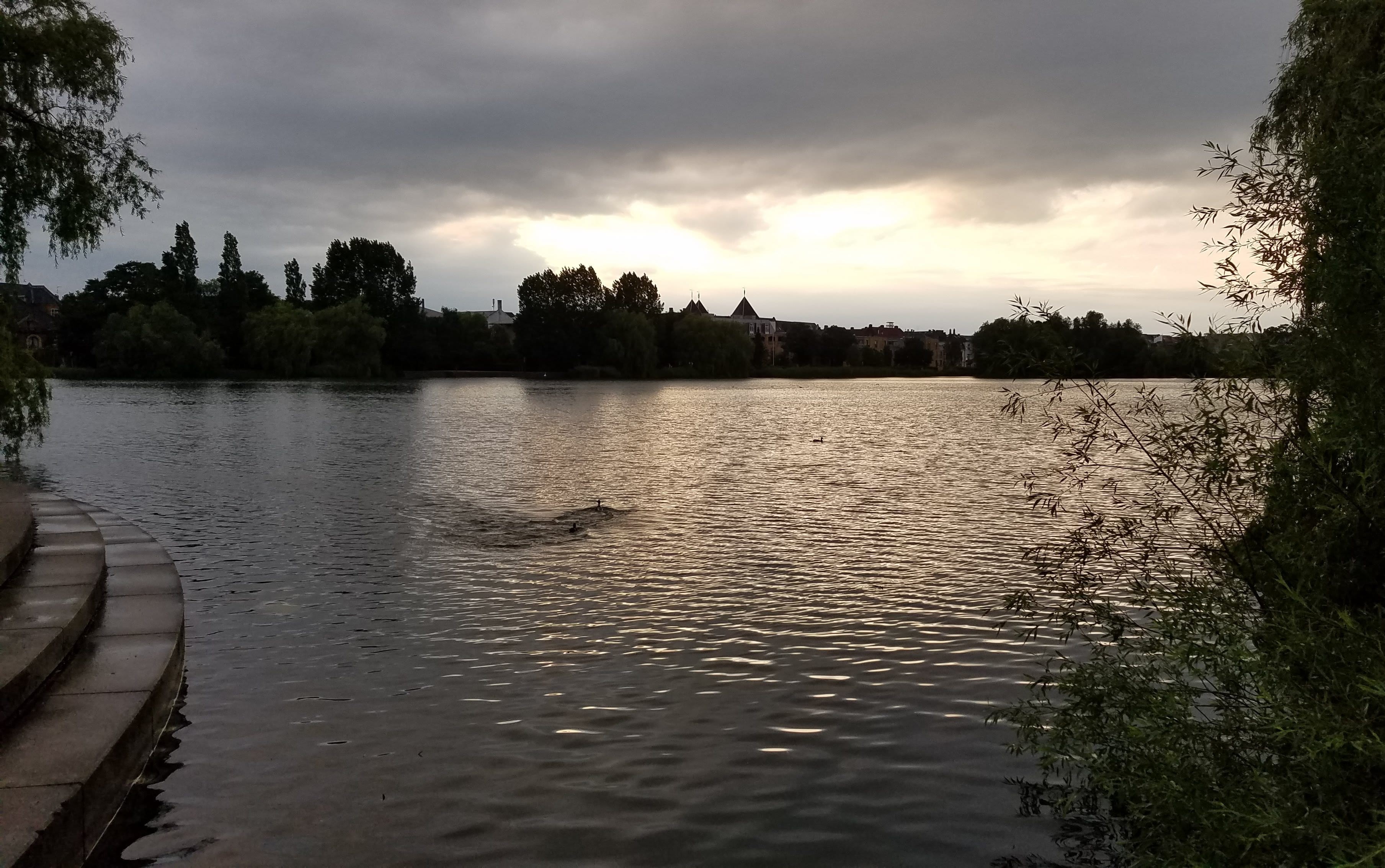
Twilight on Sankt Jørgens Sø
We took our time strolling along the shore of Sankt Jørgens Sø, enjoying the calm evening as much as the waterfowl. Just after we returned to the hotel, Michael’s phone rang. It was our daughter Stella, calling to wish him a happy Father’s Day. We had completely forgotten—but are glad that she remembered!
Leave A Comment